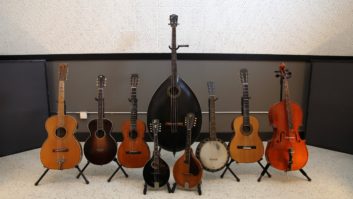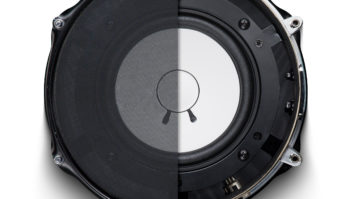Provo, UT—“We built this studio to be a great place for people to have the experience and opportunity to make their art,” says Scott Wiley, a musician, engineer, producer and owner of June Audio Recording Studios, which opened at the end of 2019 in Provo. “The community of musicians around here is really what I like most. That’s why I love being here.”
If the June Audio name rings a bell, it’s because this is the facility’s second incarnation. About 20 years ago, Wiley and his wife moved from Southern California, where they both grew up and where he studied music recording at USC, and built the original June Audio on the first floor of a mid-1920s house in Provo. They later sold the property, the studio and the gear and returned to Los Angeles, where Wiley worked at Sunset Sound, Sound Factory, Conway and other facilities. But after having kids, “I decided the lifestyle wasn’t going to work for me,” he says, and they returned to Provo.

Six or seven years ago, he began talking with Wes Lachot Design, based in Chapel Hill, NC, about building a new June Audio. He visited as many Lachot-designed studios as he could during a short trip back east. However, Wiley’s search for a suitable property over the next few years was, well, messy. Long story short, a succession of building owners, eyeing more lucrative prospects, paid him to continue looking elsewhere.
“I’ve made more money being in the way of people in my career,” he chuckles, “but it did allow us to build this place, so I’m grateful for that.”
The new location, amazingly, is the same house where the Wileys had lived previously, above the original June Audio. After discovering that the property was back on the market, Wiley calculated that Lachot’s design for the site would also fit on the deep lot behind the house and bought it—again.
“We’d been planning a studio with Wes Lachot Design for four or five years,” says Wiley. “But Wes and his team really had our backs. I’m sure they’ve raised their rates in the meantime, but they stuck with their original quotes and really helped us out.”

The old house had fallen into disrepair and had to be completely refurbished. It’s now fully outfitted as a production facility. “The downstairs is more of a proper studio in terms of size, while the upstairs rooms are editing and production suites,” Wiley reports. “We have three producers who have moved into the house. Collectively, they work for Kaskade, the DJ, and do a lot of EDM music and remixes. They have their own separate projects as well.”
Music Radar: The Top 10 Highest-Earning DJs in the World Today, by Simon Arblaster, Aug. 3, 2018
The purpose-built facility behind the house took about a year to complete. “We had a great contractor,” he says. The building’s rectangular floor plan encompasses a central hallway with a large control room and tracking space, Studio 1, on one side, with the smaller Studio 2 on the other, behind which there is a large space to warehouse—or, arguably, display—Wiley’s collection of musical instruments, backline and accessories.
“I’ve been collecting for a long time. I’ve still got my first guitar my parents bought me when I was in eighth grade,” he says. “I enjoy driving around and trying to find deals. I get lucky a lot.”
If nothing else, it’s handy having the appropriate instrument available at a moment’s notice. “You use the right snare drum and it makes your life easier—and I’m lazy,” he says. “I want to make it sound right at the source and not have to turn all these knobs.”
10 Tips for Small-Room Acoustics, by Wes Lachot, Mix magazine, March 2, 2016

Control Room 1 is a diffuse RFZ (reflection-free zone) design incorporating Brett Acoustic Slatffusors on the rear wall. “It’s a well-built room, designed by somebody who’s clearly done a lot of working studios,” says Wiley. “It’s just easy to work in. I never have to think about it.”
A 32-channel API 2448 in-line console takes pride of place in the room. “I got really used to working on APIs when I worked at Sunset Sound and Sound Factory,” he says. “We were moving forward with the idea of having a 32-channel 1608 when API introduced the 2448. I read that it’s in-line and thought, that’s the console we need. I’m enjoying having so many channels and being able to run a session all on the board.”
The room’s main monitors are ATC SCM150ASLs. A pair of Barefoot MM26s and three MM45s, plus a JL Audio Fathom subwoofer are available for 5.1 projects. “We don’t do a lot of surround, but we’re trying to be flexible,” he says.
The credenza is packed with all the usual suspects, including a pair each of Maag Audio’s EQ2 PREQ4 devices. “We’re lucky to have Maag Audio here in Provo; I know those guys well,” says Wiley. The API desk also houses four Maag EQM 500 series modules, alongside API, CAPI, Chandler, Kush and DIYRE units.
At AES: API Introduces 2448 Analog Console, Oct. 18, 2018

The 820-square-foot tracking room offers an 18-foot ceiling and variable acoustics via rotating Brett Acoustics Multifusor reflective/absorptive panels. There are three iso booths.
Across the hallway, Control Room 2, a similar RFZ design, is centered on a 32-channel Daking 1112 desk. Like Studio 1, the console is paired with Burl Mothership B80 converters and a Pro Tools HDX rig; it also features ATC SCM150 mains. The 500-square-foot tracking room, outfitted with RPG BAD panel acoustic panels, includes a single iso booth.
Wiley is keen to help up-and-coming artists from the area, which has already spawned Imagine Dragons and Neon Trees. “I just love the musicians here and the friendships. We try to keep rates low. If we could afford it, I would love to record people for free.”
Wiley has organized 24-hour recording marathons at the old studio and is currently planning another, times two. “We used to call it the June Audio 24, but we’re going to do it in both rooms, so this will be the June Audio 48. We set up all the gear and we give everybody a free hour. It’s so brutal, but it’s really fun,” he says.
“It gets a lot of people through the door and a lot of people meeting each other. I love that communal aspect.”
June Audio Recording Studios • www.juneaudio.com







